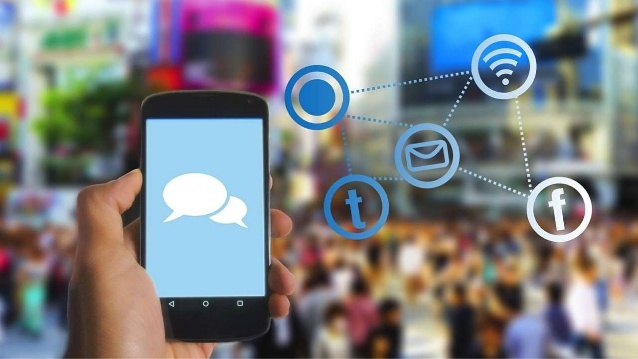
 Dakota Leest
November 15, 2018
Dakota Leest
November 15, 2018
2.9K views 0 Comments 0 Likes

Smartphones have become an integral part of human life (Abayneh, 2013; Sarwar & Soomro, 2013; Turkle, 2012). “In fact, 56% of American adults are now owners of smartphones” (Abayneh, 2013). This is primarily due to the fact that modern smartphones are able to satisfy different consumer needs. People use smartphones for entertainment, all kinds of games, correspondence with their relatives and friends, and the use of the Internet for the latest information. The developers of modern smartphones are making every effort to ensure that their invention could bring maximum benefit to their owners. Considering the technical development of smartphones on the background of programmers’ desire to make them the most popular gadgets, one can distinguish three main phases. The first era was launched in 1993 with the inception of the first smartphone The Simon from the company IBM. At that time, smartphones were oriented on being used for business purposes aimed at solving corporate problems. They successfully coped with the transfer of information and "introduced many features including Email, Internet, Fax, Web browsing, Camera" (Sarwar & Soomro, 2013, p. 217). The second phase began in 2007 and was presented by Iphone. Unlike its predecessor, this type of smartphones has been created "for general consumers market" (Sarwar & Soomro, 2013, p. 217).
Finally, the last phase, which was launched in 2008, was marked by the fact that the smartphone was to combine the possibilities for solutions for both corporate and consumer applications. The efforts of the scientists have not gone in vain, because today smartphones are extremely popular around the world among both adults and adolescents (Abayneh, 2013). At first glance, it seems that smartphones are an amazing scientific invention, which has no flaws. Indeed, smartphones have made a kind of revolution in the human world. They make it possible to combine a number of operations, such as for example, corresponding with friends and shopping. Smartphones have opened the possibility to visit the Internet and find the necessary information or to contact one’s friend or relative. Having an array of features and applications, they can be used for different purposes: business, leisure, socializing with friends and family. It is not a coincidence that the popularity of smartphones is growing every day since more and more people see the sense in use this gadget. Nevertheless, the more people become the fans of smartphones, the more often one can meet the concerns on the part of scientists. They recognize the advantages of smartphones as technical innovations that can help in dealing with various issues. However, experts from different fields (primarily medicine and sociology) point out a lot of arguments in favor of the idea that the use of smartphones brings not only benefits but also serious harm to people. Given the popularity of smartphones among people all over the world, this concern does not seem to be unnecessary or excessive.
Smartphones have an impact on various aspects of human life. Despite the fact that a smartphone is nothing more than a technical invention, its impact on human life, as it turns out, is rather strong and versatile. Often the overuse of smartphones results in their negative impact on human health (Wilson, 2012). This issue is rather serious, since scholars point to the fact that the overuse of smartphones is capable of inflicting serious damage to health, both physical and mental. Accusations of smartphones are primarily associated with the view that RF radiation emanating from smartphones can adversely affect the health of people. Scientists have shown that excessive use of smartphones can lead to sleep disturbances preventing relaxation of the brain during sleep (Abayneh, 2013). In addition, the constant use of smartphones leads to diseases related to posture (Wilson, 2012). When a person looks at the phone for a long time, his/her neck is bent, and hands are in a fixed position, which poses a serious health hazard.
Pain, muscle spasms and anxiety are only short-term effects. In the longer term, they can grow into a permanent or a chronic illness. Cervical spondylitis, elbows disease, chronic dry eye, and stiffness of thumbs, neck and back are among the many diseases caused by addiction to the wrong position, which is provoked by using smartphones. In addition to physical problems, people are often faced with psychological problems that are caused by psychological dependence on smartphones (Abayneh, 2013; Bakon & Hassan, 2013). The constant use of these gadgets leads to the fact that people cannot imagine their life without smartphones. According to statistics, Americans often take a smartphone to church (19%), in the shower (12%), or use while driving (55%) (Abayneh, 2013). This condition leads to the development of nervousness or stress in people. A person who has smartphone addiction is focused on receiving various messages, calls, photos, and other information on the phone. According to the scientists' observations, the absence of such information can cause extreme anxiety and nervousness in people (Abayneh, 2013). One can also state that the fans of smartphones are often subjects to a syndrome of phantom call. In this case, a person has auditory and motor hallucinations, because it seems to him/her that his/her phone is ringing or vibrates, though nothing happens. The disease develops in the presence of stress and is very widespread.
Negative impacts of smartphones on people can be observed among a wide segment of the population, including children and teenagers. Indeed, the problem is complicated by the fact that teenagers are the first to suffer from the negative effects of smartphones (Abayneh, 2013; Bakon & Hassan, 2013). They not only have problems with physical and mental health, teens are also faced with the problem of distraction, because many of them constantly use smartphones and do not part with them, even in the classroom. The use of smartphones can disrupt the learning process for all students, since its fast spread among schoolchildren leads to the inevitable consequences of bad studying, carelessness, detachment, social isolation etc. Another problem associated with teenagers is that by providing access to the Internet, smartphones give students the opportunity to familiarize themselves with information that can harm their mental health and moral education (such as pornography and violence). It is hard enough for parents to control the situation, which leads to the fact that the consequences can be severe, because valuable time is often neglected. Recent studies have found that the overuse of smartphones can lead to deviant behavior among adolescents (Bakon & Hassan, 2013).
In addition, the use of smartphones is related to a security problem. It is now well known that there are some programs that can easily set up one’s location and interact with other programs. Recently, there have been reports that some malware can select photos in a smartphone and send them to the Internet. Such programs are a threat to privacy, information and security. Finally, smartphones are connected to the theft of money and data leakage (Abayneh, 2013). It might seem to be strange, but a smartphone can create enough opportunities to steal money. There are games and useful applications that actually do the job of keeping the data record. The purpose of intruders is getting information from banking or payment applications. Secondly, there are many applications that one can install and use for free, but often they are asked to enter one’s own credit card information at the moment of the download or installation. As soon as the user starts to use such applications, they take money from the account of the user, even without giving notice. It often turns out that certain options of such applications are not free. In addition, many use the Internet access through the browser on their phones without a firewall or anti-virus. There is a number of malwares and viruses that can use this weakness, which is especially dangerous in the case of smartphones. People rarely log out of their accounts on frequently visited sites and applications, so personal passwords and identifiers can always be stored in one’s browsing history or data applications. In case of any type of attack, a malware can easily steal or copy personal data, photos, and other personal information.
As Abayneh (2013) notes, the negative impact of smartphones is manifested in a public sphere as well as family and kinship relations. Psychologists have conducted numerous experiments to prove that the presence of the smartphone impairs timely attention that people show in their relationship. One might ask a question of how it can happen when the Internet is full of applications for messaging and calls, not to mention the social web. The fact is that it is not about the online but offline attention. In order to communicate with their loved ones, a person should have a genuine attention, time, interest, and energy. However, it all seems to be appropriated by smartphones. Friendship maintained at the level of digital media can never replace the time spent together. This is the direct damage. One needs to take into account the damage resulting from the actual activity on the social sites with lots of people. It may seem to be surprising, but a number of studies show that in fact, these activities harm personal relationships.
Active smartphone users often stop dividing the house and the job and therefore are not satisfied with family life. This is due to the fact that people solve domestic problems during their working time or are engaged in professional issues when being with their family. Thus, people are torn between the service and the house and therefore are not satisfied with family life. This topical issue is also considered in the book Alone Together by Sherry Turkle. Turkle (2012) mentions an important shift in the minds of the users of mobile phones, since people have become more willing to write than talk. Over the past 15 years, she has studied mobile technology and talked with many people about how the new devices have changed their lives. According to Turkle (2012), electronic gadgets used by many people are able to change not only the forms of human activity, but the people themselves. For example, people are accustomed to a new understanding of the phrase "to be together." With the development of network, people can be together at a great distance. For those who live far from each other this is the only way to keep in touch. Often, however, the virtual communication replaces real friendly meetings with those who are in close proximity. People think that they are in touch with their friends, but in reality, they more and more hide from each other. Today, when people are alone, even for a few minutes, they will certainly reach for their mobile phone or other communication device. This has become almost a reflex. Psychological dependence on smartphones is complicated by the fact that it is often associated with other types of psychological dependence, such as cyber-relationship addiction, net compulsions, computer addiction etc. (Saisan, Smith, Robinson, & Segal, 2013).
The relevance of the study is determined by the need to obtain a general picture with regard to this problem by analyzing and bringing together the existing studies that focus on specific issues in relation to this problem. The aim of this study is to demonstrate the negative effects of the excessive use of smartphones globally, which has a direct impact not only on health but also on the social dimension that people live in. For this purpose, this study involves the analysis of individual studies on the negative impact of smartphones on children and adults.
The value of this study is that it gives the opportunity to become acquainted with the various investigations on the diversity of the negative factors of the use of smartphones. In fact, this study gives a complete picture of the problem, pointing out its features and forms of expression. This work focuses on the most important aspects of the problem in relation to its wide spread among adolescents and adults. Appeal to the study allows one to better understand the scope and the size of the negative effects from the use of smartphones on the background of a growing increase of their popularity.
Definition of Terms
Smartphone Addiction. A type of psychological dependence that arises as a result of excessive use of smartphones. It is observed as the constant use of the smartphone for different purposes (correspondence, sending photos and videos, listening to music, playing games, online shopping, etc.) and is accompanied by a psychological attachment to the phone. The absence of the telephone or a lack of activity on the part of virtual friends causes stress and nervousness.
Cybersex Addiction. It implies overindulgence viewing pornography, visiting rooms for adults or sites with role-playing games, which adversely affects the real family relations between spouses.
Cyber-Relationship Addiction. It is represented in the form of dependency on social networks in their diversity (Facebook, Twitter, etc.) as well as texting and exchanging of graphics and audio information with virtual friends who are considered to be more significant in comparison with people in real life.
Net Compulsions. It is directly connected with the excessive participation in online games, auctions, and online activities which are often fraught with financial loss and professional problems.
Information Overload. This refers to people who are constantly involved in database searching and web surfing, which leads to a decrease in work productivity as well as deterioration of communication with family members and friends.
Computer Addiction. It is similar to Internet Addiction (Cyber-Relationship Addiction), but is not identical to it. Computer Addiction involves excessive participation in off-line games, such as Minesweeper and Solitaire, as well as obsessive programming.
The study was conducted under the primary idea that modern society underestimates the negative impact of smartphones on human life while studies show that it is rather serious and versatile and requires effective measures to improve the situation.
The study was based on methodological assumptions, according to which the analysis of the problem should use both qualitative and quantitative research data. It will make the study more credible, reasoned, and objective.
The research was dedicated to one of the most pressing problems in today’s world, namely the negative impact of smartphones on people. The vast majority of information was gathered from analytical essay topics. There is no doubt that smartphones have a large number of advantages; however, various studies, primarily from health care, psychology, and sociology can ensure that the disadvantages of smartphones are no less significant than their advantages. The study is aimed to analyze the negative impact of smartphones on people and its features in various spheres of human life (family, professional, and educational). The objective is to present the audience a complete and truthful picture of the shortcomings of smartphones for human health, as well as human social sphere, to the maximum possible extent. Qualitative and quantitative data provided a reliable basis for the relevant findings in the study. Given that smartphones are becoming more practical and easy to use, a study of their effect on human life is a particularly important task.


